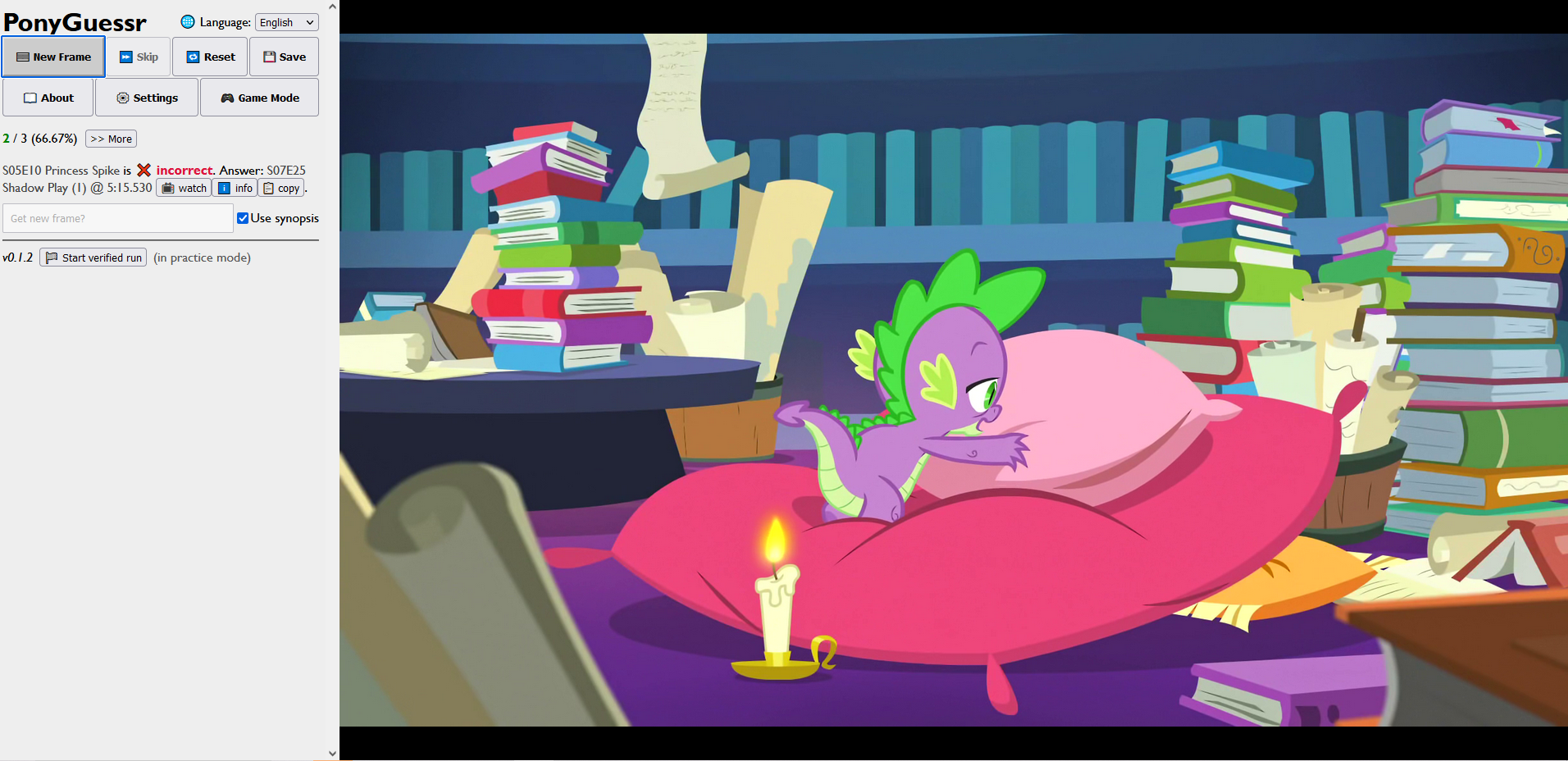Posts
-
Everfree Northwest 2023
CommentsEverfree Northwest is a My Little Pony convention in the Seattle area. It’s been running for 11 years and counting.
I told myself I was done with pony conventions after BronyCon 2019. I didn’t have long term friendships in brony fandom - what I learned long ago is that conventions are a good way to make introductions and meet people, but they don’t substitute the work of actually keeping up and maintaining friendships. This has come up in the show itself - see Amending Fences, an episode exploring the repurcussions of Twilight leaving her friends from the pilot without saying goodbye, and coming back 5 years later. It’s a common fan favorite.
Without the “I only see you at cons” dynamic that I get from ML conferences, it didn’t feel like there was much that My Little Pony cons had left to offer.
Except, I heard that with the ending of BronyCon, Everfree Northwest is the largest pony convention left. I’d never been to Everfree before, and its continued existence was not guaranteed. Surely I should check it out? And I knew friends in the Seattle area I could catch up with if I stopped by…
I went back and forth and back and forth and eventually decided, screw it, let’s go. It’s worth going at least once.
My General Reaction
Oh no, I had fun.
Oh no, Everfree Northwest actually had slightly more attendees this year than last year.
From an objective standpoint, EFNW was not that much better than previous MLP convention experiences I’ve had. But I still thought it was worth it??? If I don’t need an amazing experience to decide these cons are worth attending, and their attendance stays stable…am I going to pony conventions for all eternity? I thought I was done with these events! IS THIS MY LIFE NOW???
OH NO
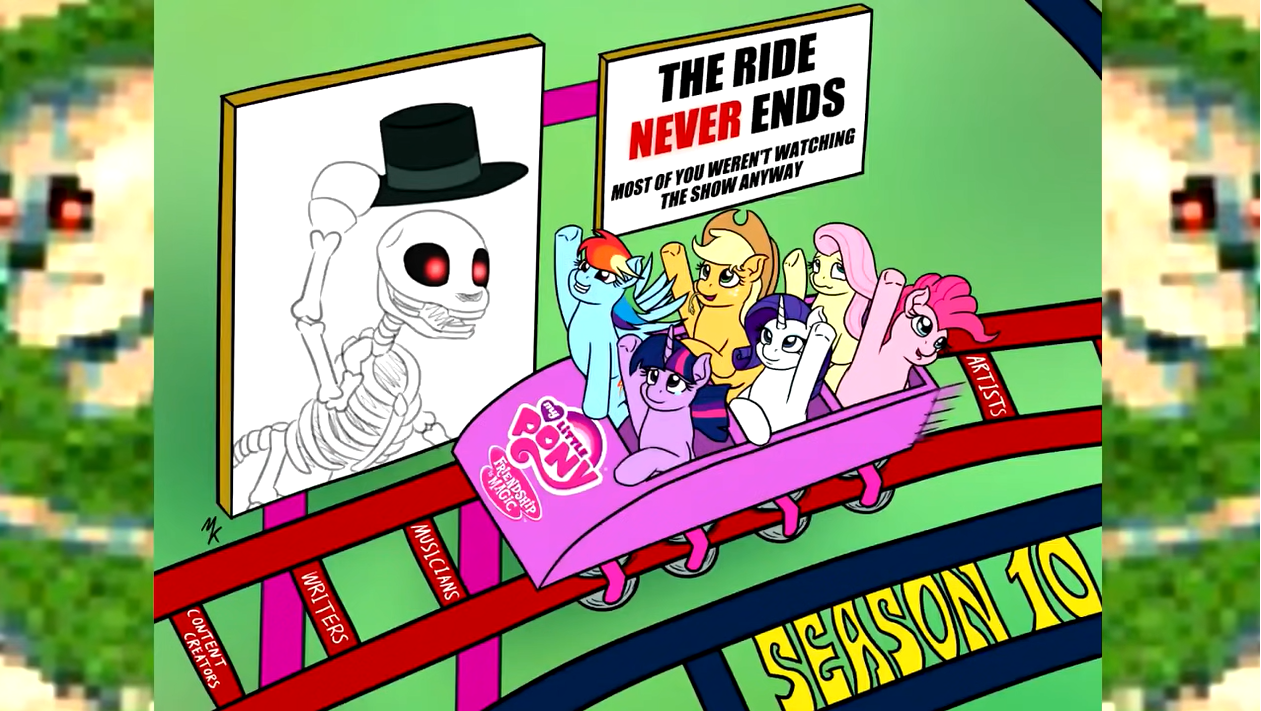
“Steve, do you know the first thing I said to myself when I realized I was a brony?”
“What?”
I look him dead in the eye, and say “Shit.”
ACRacebest, describing his appearance on “Is it Weird?” on The Steve Harvey Show
“I am Cringe, but I am Free” - Socrates, probably
The classic first sight at any MLP convention is a furry in a fursuit. Every brony will tell you that bronies are not furries. Every 2023 brony will tell you that at this point there’s a pretty strong overlap.
Still, these cons are a low judgment zone. Not zero, but low. There’s definitely a vibe of “finally, I can express myself”. I don’t really try to hide my brony fandom, but I don’t go out of my way to express it either. During the con, I talked to one person who felt similarly, although he said he doesn’t wear pony shirts for personal safety reasons. He lives in a red state and isn’t sure what would happen if he was more “out” about it. My suspicion is that the majority of people would not care, there are plenty of out-and-proud bronies that live in Republican areas, have served in the military, etc. However, this is one of those things with “few idiots ruin everything” dynamics, and I can understand their choice.
These cons always have a bit of “nerd bleedover”, so to speak. One of the first events of the con was purely a meet-and-greet “make new friends” panel, for people willing to meet new people but unsure how to start conversations. (“I’m in this photo and I don’t like it.”) I ended up in many, many more Marvel and gaming discussions than expected.
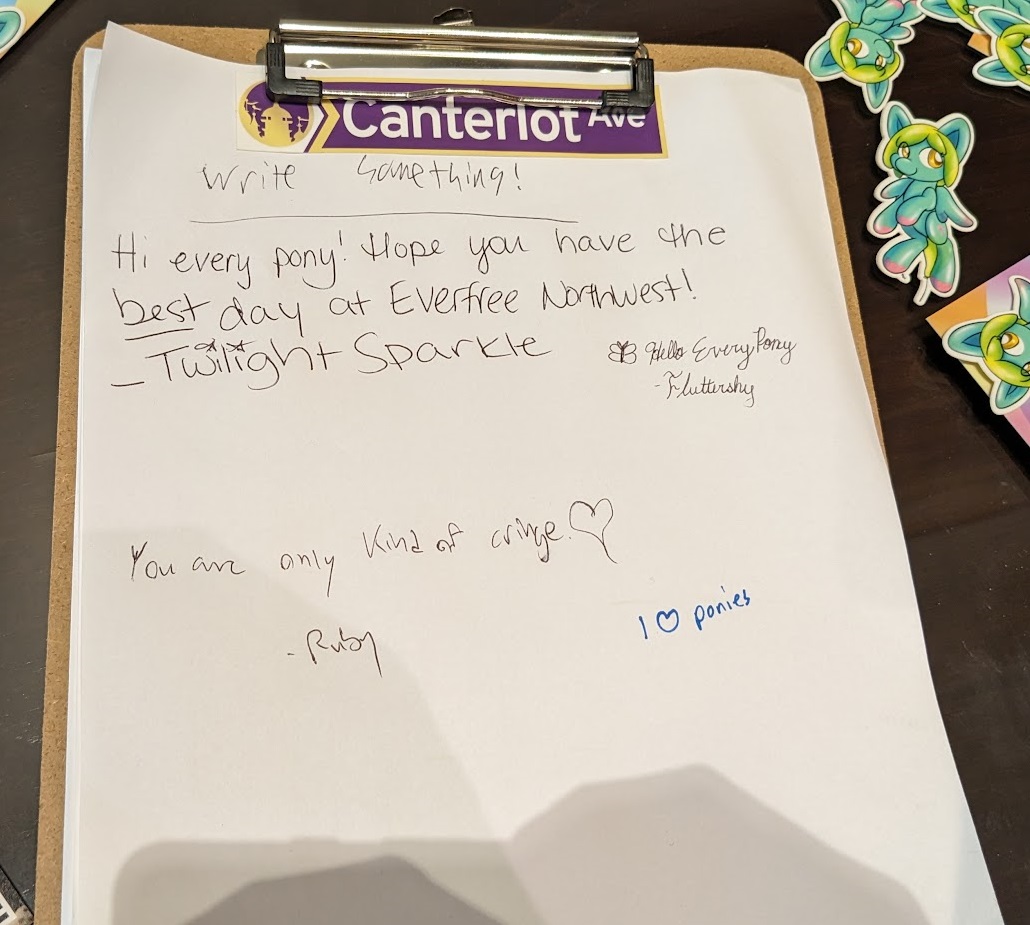
Guests of Honor
If you’ve never been to a fan convention at all, one commonality is actors coming to talk about their show experience, meet fans, and sell autographs. This year, most of the people giving autographs were from G5.
A quick recap: the My Little Pony franchise is split into different “generations”. The original 1980s show is retroactively called Generation 1, and it’s counted up since then. My Little Pony: Friendship is Magic is Generation 4, or G4, and is the one that kicked off the brony fandom. Some people who continued to the G5 reboot, and…it’s controversial. I watched the movie, and it struck me as “obviously flawed, but has glimmers of true quality.” I am very basic so Izzy’s my favorite. If you watched G4, she’s Pinkie Pie, except she’s a unicorn and more grounded. If you haven’t, think Luna Lovegood.
I haven’t watched anything else from G5 yet because people told me it’s not up to G4 standards. Still, it’s found its fans, and I’ve heard the quality is trending up.
Cons and fan artists have started featuring more G5 content, but the G4 mainstays still have a big chokehold. The surprise guests this year were Nicole Oliver and Tabitha St. Germain, two of the Friendship is Magic voice actors, and their lines were very obviously longer than any of the G5 voice actor lines. Some voice actors from The Owl House got invited too. Their lines were also short. People like The Owl House, I have yet to hear anything bad and there’s lots of fanbase overlap. But people just aren’t fans of The Owl House in the way they’re fans of Friendship is Magic.
In the future, it’s possible cons will continue to drift towards generic animation to help pay the bills. I think this is a bit sad, but may be a necessary tax to keep the Friendship is Magic parts going.
A Programming Break
There’s a lot of software engineers in the brony fandom. It’s not obvious why, but it leads to cool projects, I won’t complain.
At the Pony Programming Panel, there were multiple presentations on MLP projects. My favorite is easily PonyGuessr, a game about IDing My Little Pony episodes from a single still frame. I’ve tried playing this for fun, and without Google I can manage a 50% hit rate if I give myself infinite time to make a best guess. (You can access all episode titles and synopses, so even a vague guess on the season or plot is enough to narrow down the exact episode by brute force.) Of course there is a speedrun category, it was kicked off by Tridashie putting up a $2000 prize pool for fastest times. It is already terrifyingly optimized and at the con I saw people hitting 90% accuracy with 10 seconds of thinking time - which is not at all competitive with world record runs.
(click for full size)
Another project was from someone trying to finetune an LLM to act as CelestAI from the Friendship is Optimal-verse. To very briefly paraphrase the presenter, “Friendship is Optimal is a fanfiction series set on Earth, where a superintelligent AGI named CelestAI is put in charge of a My Little Pony MMO. It’s told to maximize user satisfaction through ponies.” There is an entire subgenre of “people concerned about AI alignment write fanfiction” and the story unfolds in the way you’d expect of that genre. Now, this project in particular was born from someone deciding they wanted CelestAI in their life. I’m not quite sure that’s the right reaction to have after reading Friendship is Optimal, but it was interesting to see someone reinvent a synthetic data pipeline.
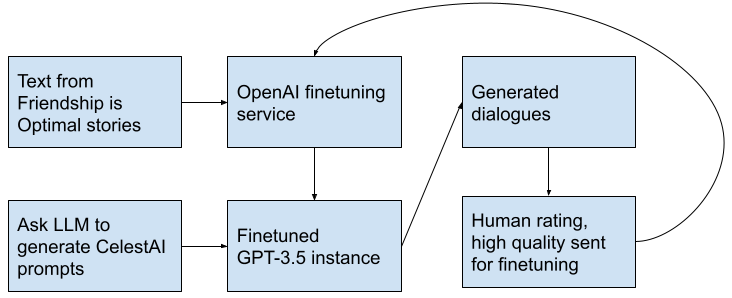
The output isn’t that bad, although it definitely suffers if you stray from the narrow path of talking about ponies.
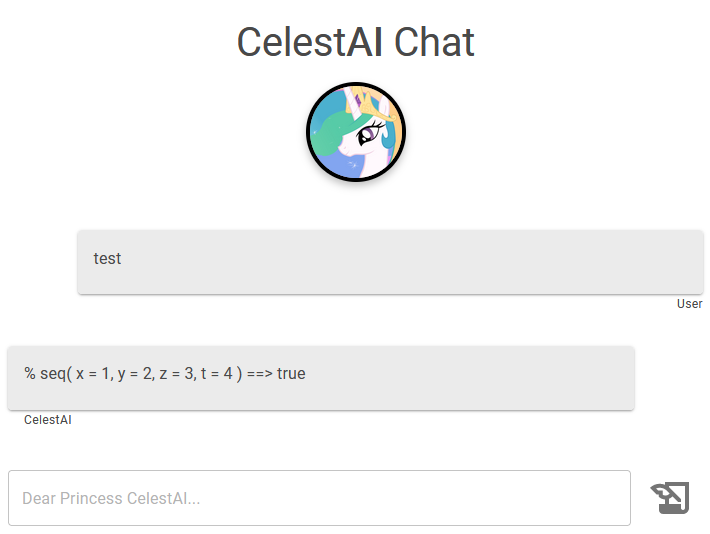
I’ve talked about generative AI in My Little Pony before, and I think the reason these projects come from the fandom is that the MLP fandom has the right combination of appetite and technical experience to make these projects more than pipe dreams.
The last project presented was, well, I’d describe it as more of a therapy session. The presenter self-introduced themselves as “an Amazon engineer that works on things that don’t matter”, then went on a rant about 8 years of poor tech decisions they made, why they were declaring tech debt bankruptcy, and why most programming languages are awful. I learned nothing.
Twilight’s Book Nook
There’s a lot of My Little Pony fanfiction out there. It’s slowing down, but there are at least 3 fan projects based on publishing fanfiction at-cost. The big one I followed for a bit was Ministry of Image, named after an organization in kkat’s Fallout Equestria. Their books looked great, but their main issue was that they shipped out of Russia, which meant a large shipping cost pre-Ukraine and an “uhhhhh” post-Ukraine.
Twilight’s Book Nook is, roughly, an aggregator that gets books from the different publishing projects, and then goes to conventions to advertise and sell them. The books aren’t actually cheaper, they pass on the Russian shipping cost to con-goers, but I decided to take the chance to pick up some copies I was interested in.

I haven’t read Prey yet, and got it almost exclusively off it being written by kkat. Fallout Equestria is easily my favorite MLP fanfic and I’ll defend it as genuinely high quality outside its fanfiction trappings. “We were racing apotheosis and we were losing” still lives rent-free in my head. Hopefully Prey lives up to those expectations. The thing I appreciate about kkat is their concise style and character building, avoiding the meandering fluff that tends to plague fanfic.
“How Long Are You Out Again?”
All the pony conventions I’ve been to have raves at night. Everfree Northwest’s was called Ponystock.
Are these raves good? Ehhhhhhh. I’d say that question is missing the point. The point of these events is to give people an experience they wouldn’t get elsewhere. The average brony is not going to go to an EDM concert, and the average brony musician is not going to get a chance to perform for such a specific crowd of pony enthusiasts. I went to one of the “My Little Karoake” sessions and it was great. Where else will you get a group singalong of “You’ll Play Your Part”?
Even then, the amount of “pony music” is always a point of contention. People tend to assume that “pony concert” means “remixes of pony songs”, or at least “overt references to My Little Pony”. These days, most of the pony musicians are people who take inspiration from the show, but basically write whatever music they want. It is very common for people to do instrumental music with no clear connection to MLP at all. People who met for different reasons but now celebrate each other.
I wrote the lyrics myself which also was a first time for me and I wanted the song to be something where anybody can imagine someone special who this song is for. So at first it doesn’t feel like a pony song and you could play it in front of a big crowd and people will love it.
But secretly I wrote this song about Twilight haha ;)
AnNy Tr3e, on “You Are My Star”
If you haven’t been following the brony music scene, this can be a bit disconcerting. Personally the brony music scene is one of the few parts of the fandom I keep up to date with, so it works out for me. I used to look down on the pony raves, because they look lame, and then over time decided that I should stop worrying about that and just go dance poorly with everyone else. To quote ANTONYMPH,
Don’t care you think it’s cringe, because it’s not your life
I was out until 2 AM every night, to the consternation of the people I was staying with.
By the way, if you haven’t seen the music video for ANTONYMPH yet, and were someone who grew up on the Internet in the 2000s or early 2010s, I highly recommend watching it. It has many very targeted references to that era of viral culture. ANTONYMPH has had a surprisingly strong impact on the fandom (I saw some ANTONYMPH music video cosplays this year), and I’d say it’s because the brony fandom has existed long enough to have nostalgia for itself and where it came from. At the vendor hall, I came across someone reselling Neopets merch, and I’d say that’s more for age overlap reasons than fandom overlap reasons.
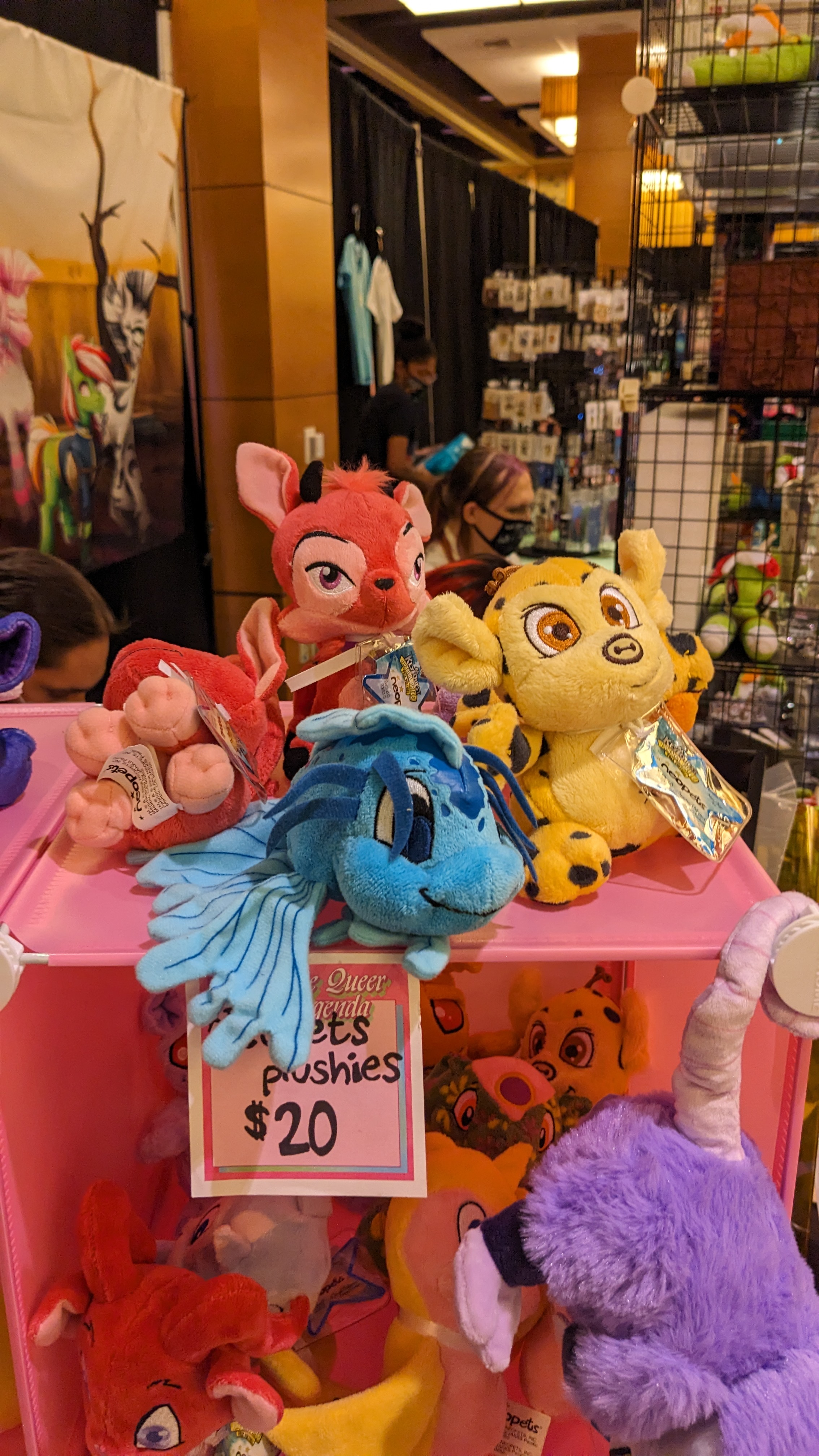
Tonight We Gonna Party Til The Party Don’t Stop
Not everyone at a pony con is over 21, but you get enough adults of the right age together and people will want to drink.
The way Everfree Northwest handles this is with a dedicated “party floor”. A few conference suites at the hotel hosting the event are designated as party rooms. Community organizers will host late night parties out of those rooms. The idea is to control the degeneracy, by centralizing the drinking in a place with good norms. All these parties will have the same rules:
- Everyone’s ID gets checked. No exceptions.
- If you take a drink, you finish it or pour it out before leaving the room. There are plenty of minors at pony conventions and con staff wants no part in enabling underage drinking.
- Someone trained on first-aid for drunk people will be around all night.
- No one can charge for alcohol. I believe this is because of liquor license reasons, so it means all rooms run on a donation-only system.
You run into some weird people at these parties. The Bay Area pony convention often has a party run by a group of Trekkies who decorate the room in Klingon gear. I’ve been told it’s part of their conversion process for spreading the good word? And then at Everfree I ended up in the BerryTube room, which grew from a weekly My Little Pony drinking game to a bunch of people who group watch random MLP-adjacent videos, chant “HAIL HYDRATE” every so often, and insist they aren’t a cult. You know, standard stuff. They’re named after Berry Punch, the character that’s an alcoholic (or at least, as far as you can imply that in a kid’s show).
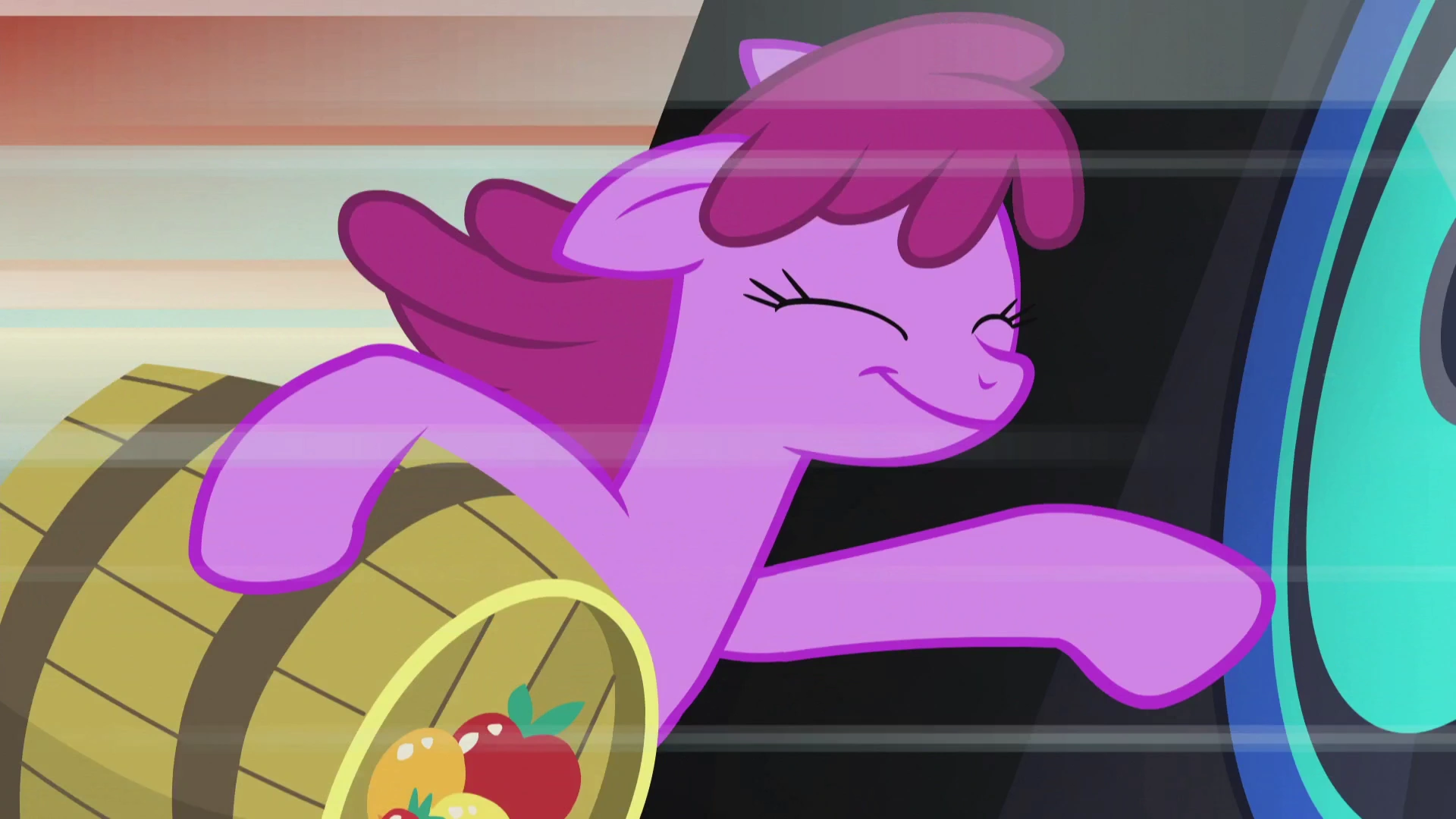
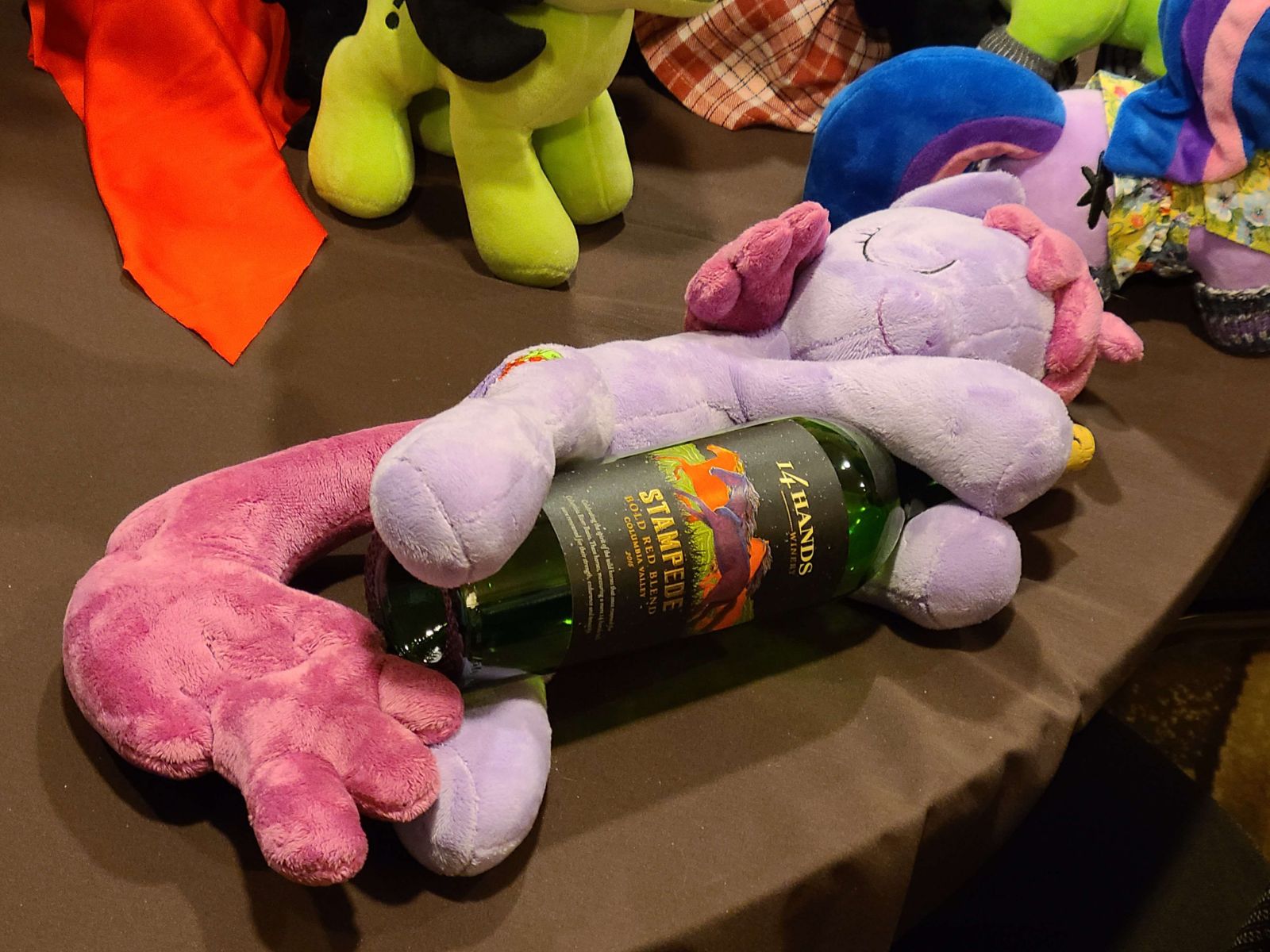
I learned all this from socializing with a member. “Yeah, we have people from all over. A few people from Europe. No Asians though-“
At which point a BerryTube regular said “OH MY GOD how can you say that to an Asian person” and then we laughed as he desperately tried to clarify the context and failed. The interrupter said I shouldn’t worry, she couldn’t be racist towards Asians because she had a black trans boyfriend who was really into K-pop. I mentioned that I was friends with a black gay guy who was into K-pop, and we briefly shared common ground over our token black LGBT Koreaboos.
There Was a MLP Card Game?
Yes! It also…has a surprising amount of complexity to it?
I went to one of the “learn to play” events since I had the free time and was curious. And, I don’t think there’s an easy summary of how the game works. It’s a little like Commander, where every deck has a double-sided “Mane Character” that always starts in play, but it can “level up” when you meet a condition. It’s a little like Marvel Snap, where there are zones that you compete over and earn points if your total power is stronger, but the zones are determined by your deck, so an aggro / control deck can pick zones appropriately. Then there’s way more rules on top of that. If I actually had someone to regularly play it with, maybe I’d buy the cards for it, but I don’t and the game’s out of print anyways. Still a bit of a trip to hear about a Princess Cadance Reanimator deck though. Those are not the words I expected to fit together.
The Charity Auction
The last event before closing ceremonies was a charity auction. This happens at other cons too. Each year the con picks a charity, people donate items to auction off, and they get sold in one big event at the end.
It’s a long-running observation that a lot of furries work in tech. A lot of bronies are in tech too. Combine disposable income with “the money goes to charity” and a desire to flex at a public auction, and you have a recipe for really high bids. $500, for an autographed photo of Tara Strong! $250, for a jar of honey! I have always tried to make these events, because you see cool things go up for bidding. I have never walked away with anything, because my price tolerance is not high enough to compete. I saw a huge bid for some pony themed license plates, and later learned the winner lived in Palo Alto and has a car restoration hobby. You can fill in the blanks from there.
I was only willing to overpay on two items. The first was a signed copy of Ponies: The Galloping, the Magic: The Gathering x My Little Pony crossover. They only printed it once, and I knew they sold on eBay for about $200. So I set a personal bidding cap of $300, and they sold for $500.
The second was a plushie and set of red envelopes with My Little Pony characters on the front, signed by a voice actor when they were promoting the MLP movie in China. They’re red envelopes, they’re cheap! Sure, there’s an autograph premium, but I figured that I could irresponsibly go up to $100 and have a shot.
They ended up going for $350. Ah well. There are ways to signal allegiance besides money.
Speaking of the Chinese brony scene, it only lightly interacts with the English scene and I don’t know much about it. The one native Chinese brony I’ve met said it trends younger, and the scene can face visa troubles when going to the US. I also have a link to a MLP bilibili slang spreadsheet that’s very excellent. Nicknaming Starlight Glimmer “Communist Secretary” hits different when someone from China does it.
FOMO
Unfortunately, I ended up catching COVID from the con.
Now, ahead of time, I had considered the COVID risk and considered it within my risk tolerance. Adaptations of recent strains to be more mild, full vaccination suite with bivalent booster, etc. Symptom-wise, that all played out fine, I essentially just had a mild fever and cough. The part I did not account for was that I’d have to cancel all my planned social meetups while staying-in-place. That sucked. The COVID risk was low but the FOMO risk was high.
I definitely still would have gone to the con if I had given it more consideration, but I would have been a bit more diligent about masking protocols. Ah well. That dampened things a bit, but I will (probably) still be back next year.
-
Eight Years Later
CommentsSorta Insightful turns eight years old today!
I am writing this while traveling and sick with COVID, which is the clearest sign that I am in this for the long haul. I don’t remember where it’s from, but long ago I remember reading a novelist’s guide for how to write a novel. It had a bunch of typical advice, but ended with “sometimes the way to write a novel is to just go write a f***ing novel.” That’s where I’m at with this blog.
I have a bit of an ADHD relationship with writing, where I will go a long time without writing anything, then stay up until 5 AM revising a post. Getting started is hard but sustaining effort is easy.
Highlights
I’m done with writing MIT Mystery Hunt! Freedom!
The post about it was pretty rewarding to write, although “post” may be the wrong word. Credit to CJ for noting that the post was long enough to pass NaNoWriMo.
Did it need to be that long? Eh, probably not, but I kept having ideas I wanted to put in. I also knew I was not in a mood to revise it to be shorter. The revisions I did were focused on grammar, word choice, and overall flow, rather than deciding if an idea should be cut. (Feel free to draw a comparison to the Hunt itself if you want.)
To be honest, I do not expect to write a post of that length again. I started working on that post right after Mystery Hunt 2023 finished, and hardcore focused on getting it out ASAP. “As soon as possible” turned out to be 3 months, ending right when planning for ABCDE:FG ramped up. The end result was that I was exerting “write Mystery Hunt” levels of effort (10-20 hrs/week) for 1.5 years straight. That was just too much, and I burned out on doing anything with my free time besides vegetating.
My burnout lined up almost exactly with getting a copy of The Legend of Zelda: Tears of the Kingdom. Let’s say my escapism into TotK was especially therapeutic. I’m done with the game now, and am still adjusting to not having a “default” action taking up mindshare. “I should write a puzzle”, “I should write about writing puzzles”, or “I should go find more Koroks” have been like, the only three thoughts I’ve had outside of work since last year. Gotta have more thoughts than those!
Statistics
Posts
I wrote 6 posts this year, down from 7 last year. In my defense, this is a bit misleading, especially if I pull up the time stats.
Time Spent
I spent 189 hours, 45 minutes writing for my blog this year, around 1.9x as long as last year.
Around 170 hours of that was on the Mystery Hunt retrospective post.
View Counts
These are view counts from August 18, 2022 to today.
259 2022-08-18-seven-years.markdown 372 2022-10-01-generative-modeling.markdown 333 2023-01-20-mh-2023-prelude.markdown 1929 2023-04-21-mh-2023.markdown 114 2023-05-09-bootes-2023.markdown 153 2023-07-19-ml-hurry.markdownPosts in Limbo
Post about Dominion Online:
Odds of writing this year: 5%
Odds of writing eventually: 25%My priorities are moving away from Dominion. This may be the first year I skip the yearly championship, I’m not too interested in grinding my skill level back up. Still, I can’t let go of writing this eventually.
Post about Dustforce:
Odds of writing this year: 20%
Odds of writing eventually: 60%I still think Dustforce is one of the best platformers of all time. I’ve been playing a lot more Celeste recently thanks to Strawberry Jam, but Dustforce still does some things that no one else has replicated in a satisfying way.
Post about puzzlehunting 201:
Odds of writing this year: 50%
Odds of writing eventually: 90%This is a post I’ve been considering for a while. There are introduction to puzzlehunt posts, a so-called “puzzlehunt 101”, but there is no “puzzlehunting 201” for people familiar with the basics and interested in solving faster. I was going to write this last year, embedding puzzle content in it for Mystery Hunt, but didn’t have a solid puzzle idea and got too busy. Now I’m less busy.
Post about AI timelines:
Odds of writing this year: 90%
Odds of writing eventually: 99%I’m not planning a big update to the last timelines post. I just think it’s time to review what I wrote last time, given that it’s been 3 years. (And selfishly, because I think I called a lot of things correctly and want to brag about that.)
-
Machine Learning Got Itself in a Big Damn Hurry
CommentsThree months ago, I was at an “Intersection of AI and My Little Pony Fandom” panel. It was a panel about the ways the MLP fandom has used AI to generate creative work, starting from finetuned GPT-2 in 2020, through voice synthesis via 15.ai, and ending with, of course, Stable Diffusion. More specifically, the finetuned Pony Diffusion checkpoint, whose finetuning cost is estimated as tens of thousands of dollars. The talk ended with a proof-of-concept of a Discord bot that roleplayed a pony, via GPT-3.5, whose avatar was in-painted to diffe1ent expressions based on emotions inferred from chat history.
As I asked questions about compute resources and the presenter’s position on generative AI ethics, I had a moment of realization. I was at a pony convention. Why are we talking about whether an RTX 3090 is big enough to finetune a LLaMa checkpoint? How are we talking about Vicuna, here of all places, while people are dressed up in cosplay next door?

When people talk about technology improving more quickly, it usually evokes thoughts of the singularity. Technology indistinguishable from magic, making it easier to create more magic. But, culture and communication are technologies too. The much easier and less-speculative way for a field to move faster is by having more people working in that field. If research is an API call away, then congratulations, we’ve democratized ML, as long as you’re willing to pay for access. Combine that with the adoption of low-friction social media (aka Twitter), and you’ve got something going.
If the engine of invention is powered by people sharing random ideas until good ones emerge, then I can’t help but wonder if the best inventions are ones that make sharing ideas easier.
(Previous post about How to Invent Everything)
This field is just getting so big. Things change so fast! The MLP AI enthusiasts mentioned some pretrained LLMs that I had not even heard of. It’s not my field, but, like, I do this for a living. I was easily top 1% generative AI knowledge among bronies in 2020. Now I’m like, top 5%? A 5x increase sounds right. I can only attribute the growth to one truth: there are signs of life, and people are hungry.
I remember being a young whippersnapper, in the deep learning wave of 2015. Then I was the new guard. The old guard would complain that “You can’t just take an old idea, do it with a neural net, call it deep learning, and claim that part of ML for deep learning”, as researchers continued to take old ideas and reshape the field around a different MLP: the multilayer perceptron. Now people do the same thing with LLMs.
The flood is growing, and my time to drink from it is the same. Deciding what to drink is getting harder.
I’m noticing a trend of people posting LLM summaries of papers, talks, etc. They’re always attributed to the LLM, and they’re never fact-checked. I have a long history of learning and appreciating that the map is not the territory, and this trend is a bit like if people who loved maps got access to a map-making tool and created a billion maps. It is not even that they understand they’re working with approximations of reality. That would be better. What’s happening is that they don’t care they’re on an approximation of reality. If you like searching for truth, it is a very personal kind of hell.
The bitter lesson I’m taking is that I will have to get used to this. I will have to use an LLM where I can explain the loss function, but can’t explain the emergent phenomena. I will have to learn all the random tricks people have found for LLM prompting. There is going to be too much content to accept any non-augmented workflow. Such is the future of knowledge work.
“But why is this prompt so effective? Do we have a way to inspect what preferences the RLHF reward has extrapolated, given the preference labels we have?”
“The stuff is what the stuff is, brother! Accept the mystery.”
